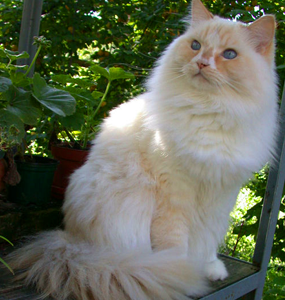Background:
This breed first pounces in during the 1960s. Ann Baker, also a Breeder of Persian cats, is credited with their introduction. Before breeding, Anne looked after her neighbor’s cat: Josephine. Josephine, a white domestic longhair, had been injured after being struck by a car. After she recovered she produced a litter of extremely friendly and special kittens, which Baker purchased from Josephine’s owner believing their sweetness and sociability could have been a result of the accident.
Baker began breeding Josephine’s kittens in the hopes of duplicating their sweet personalities. At the time she called them Cherubim, in reference to the angelic beings mentioned in the Hebrew Bible. The most famous Cherubims were Buckwheat and Daddy Warbucks.
Cat Facts:
- The Ragamuffin is cousin to the Ragdoll.
- The Ragamuffin weighs in around 10-20 lbs.
- The Ragamuffin can come in all coat colors and patterns.
- The “rag” part in their name is given because they love to go limp while lying in your arms.
What's the Ragamuffin like?
When you own a Ragamuffin it’s like you’ve placed a magnet on yourself and the attracting magnet in your cat. They’ll follow you everywhere! Almost doglike, Ragamuffins love to greet you and your guests at the door.
The Ragamuffin is prone to periodontal disease, so brush your cat’s teeth whenever you can to try and avoid this. There are also a couple of hereditary issues to be aware of: hypertrophic cardiomyopathy and polycystic kidney disease.
Takeaway Points:
- Ragamuffins were tailor made for households with young children. Because this breed is so calm and sweet they love playing with little ones and don’t mind traveling around in little doll carriages.
- Ragamuffins are so outgoing that they make great travelling buddies and can even learn to walk on a leash!
- Because of their silky coat use a comb rather than a brush to prevent tangles but always be gentle! A regular teeth brushing is also very good routine to prevent periodontal disease.
- If you have allergies this cat can make them worse because they produce dander or dead skin cells (although no cat breed is better or worse for people with allergies).
If you have any questions or concerns, you should always visit or call your veterinarian – they are your best resource to ensure the health and well-being of your pets.
